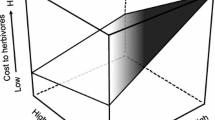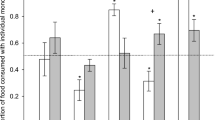Abstract
Mammalian herbivores, particularly browsers and folivores, encounter and consume a range of plant chemical defenses [plant secondary metabolites (PSMs)] on a regular basis. The physiological regulation of PSM ingestion and the resulting behavioral responses of mammalian herbivores directly affect their feeding decisions and the subsequent foraging strategies that they adopt. Generalist mammalian herbivores are hypothesized to consume a generalized diet because of physiological limitations of their detoxification systems. The consumption of a generalized diet is proposed to enable toxin (PSM) dilution through the use of multiple detoxification pathways. We tested the predictions of the detoxification–limitation hypothesis by offering two chemically different plant species, Eucalyptus regnans and E. globulus, to a generalist mammalian folivore, the common brushtail possum (Trichosurus vulpecula), as single- and mixed-species diets. By feeding more efficiently, brushtail possums benefited more, through increased intake, on the mixed-species diet than on either of the single-species diets. We argue that frequently switching between chemically diverse foliage reduces the physiological constraints imposed by a PSM-rich diet and enables more efficient feeding. The behavioral responses of brushtail possums were consistent with the proposed physiological constraints of a chemically defended diet, offering support for predictions of the detoxification–limitation hypothesis. We suggest that feeding behavior of herbivores may be a useful indicator of the physiological constraints imposed by a chemically defended diet.





Similar content being viewed by others
References
ANKOM220/220 Fiber Analyzer Operator's Manual. 1997. ANKOM Technology, Fairport, NY, USA.
Boyle, R. and McLean, S. 2004. Constraint of feeding by chronic ingestion of 1,8-cineole in the brushtail possum (Trichosurus vulpecula). J. Chem. Ecol. 30:757–775.
Boyle, R., McLean, S., Foley, W. J., and Davies, N. W. 1999. Comparative metabolism of dietary terpene, p-cymene, in generalist and specialist folivorous marsupials. J. Chem. Ecol. 25:2109–2126.
Boyle, R., McLean, S., Brandon, S., and Wiggins, N. L. 2005. Rapid absorption of dietary 1,8-cineole results in critical blood concentration of cineole and immediate cessation of eating in the common brushtail possum (Trichosurus vulpecula). J. Chem. Ecol. 31:2775–2790.
Bryant, J. P. and Kuropat, P. J. 1980. Selection of winter forage by subarctic browsing vertebrates: the role of plant chemistry. Ann. Rev. Ecolog. Syst. 11:261–285.
Chilcott, M. J. and Hume, I. D. 1984. Digestion of Eucalyptus andrewsii foliage by the common ringtail possum, Pseudocheirus peregrinus. Aust. J. Zool. 32:605–613.
Close, D. C., Davies, N. W., and Beadle, C. L. 2001. Temporal variation of tannins (galloylglucoses), flavonols and anthocyanins in leaves of Eucalyptus nitens seedlings: implications for light attenuation and antioxidant activities. Aust. J. Plant Physiol. 28:269–278.
Cork, S. J. and Foley, W. J. 1991. Digestive and metabolic strategies of arboreal mammalian folivores in relation to chemical defenses in temperate and tropical forests, pp. 133–166, in R. T. Palo and C. T. Robbins (eds.). Plant Defenses Against Mammalian Herbivory. CRC Press, Boca Raton, FL.
Dearing, D. M. and Cork, S. 1999. Role of detoxification of plant secondary compounds on diet breadth in a mammalian herbivore, Trichosurus vulpecula. J. Chem. Ecol. 25:1205–1219.
Dearing, D. M., Mangione, A. M., and Karasov, W. H. 2000. Diet breadth of mammalian herbivores: nutrient versus detoxification constraints. Oecologia 123:397–405.
Faulkner, W. R. and King, J. W. 1970. Renal function, pp. 975–1014, in N. W. Tietz (ed.). Fundamentals of Clinical Chemistry. W. B. Saunders Company, London.
Feeny, P. 1970. Seasonal changes in oak leaf tannins and nutrients as a cause of spring feeding by winter moth caterpillars ecology. Ecology 51:565–581.
Foley, W. J. 1992. Nitrogen and energy retention and acid–base status in the common ringtail possum (Pseudocheirus peregrinus): evidence of the effects of absorbed allelochemicals. Physiol. Zool. 65:403–421.
Foley, W. J., McLean, S., and Cork, S. J. 1995. Consequences of biotransformation of plant secondary metabolites on acid–base metabolism in mammals—a final common pathway? J. Chem. Ecol. 21:721–743.
Freeland, W. J. 1991. Plant secondary metabolites: biochemical coevolution with herbivores, pp. 61–81, in R. T. Palo and C. T. Robbins (eds.). Plant Defenses Against Mammalian Herbivory. CRC Press, Boca Raton, FL.
Freeland, W. J. and Janzen, D. H. 1974. Strategies in herbivory by mammals: the role of plant secondary compounds. Am. Nat. 108:269–289.
Hamm, L. L. and Simon, E. E. 1987. Roles and mechanisms of urinary buffer excretion. Am. J. Physiol. 253:595–605.
Jones, T. H., Potts, B. M., Vaillancourt, R. E., and Davies, N. W. 2002. Genetic resistance of Eucalyptus globulus to autumn gum moth defoliation and the role of cuticular waxes. Can. J. For. Res. 32:1961–1969.
Kerle, J. A. 1984. Variation in the ecology of Trichosurus: its adaptive significance, pp. 115–128, in A. P. Smith and I. D. Hume (eds.). Possums and Gliders. Surrey Beatty & Sons, Sydney.
Lawler, I. R., Foley, W. J., Eschler, B. M., Pass, D. M., and Handasyde, K. 1998. Intraspecific variation in Eucalyptus secondary metabolites determines food intake by folivorous marsupials. Oecologia 116:160–169.
Lowther, J. R. 1980. Use of a single sulphuric acid–hydrogen peroxide digest for the analysis of Pinus radiata needles. Commun. Soil Sci. Plant 11:175–188.
McArthur, C., Hagerman, A. E., and Robbins, C. T. 1991. Physiological strategies of mammalian herbivores against plant defenses, pp. 103–114, in R. T. Palo and C. T. Robbins (eds). Plant Defenses Against Mammalian Herbivory. CRC Press, Boca Raton, FL.
McArthur, C., Goodwin, A., and Turner, S. 2000. Preferences, selection and damage to seedlings under changing availability by two marsupial herbivores. For. Ecol. Manag. 139:157–173.
Marsh, K. J., Wallis, I. R., and Foley, W. J. 2005. Detoxification rates constrain feeding in common brushtail possums (Trichosurus vulpecula). Ecology 86:2946–2954.
Marsh, K. J., Wallis, I. R., McLean, S., Sorensen, J. S., and Foley, W. J. 2006. Conflicting demands on detoxification pathways influence how common brushtail possums choose their diets. Ecology (in press).
O'Reilly-Wapstra, J. M., McArthur, C., and Potts, B. M. 2004. Linking plant genotype, plant defensive chemistry and mammal browsing in a Eucalyptus species. Funct. Ecol. 18:677–684.
Pfister, J. A., Provenza, F. D., Manners, G. D., Gardner, D. R., and Ralphs, M. H. 1997. Tall larkspur ingestion: can cattle regulate intake below toxic levels? J. Chem. Ecol. 23:759–777.
Ratkowsky, D. A., Evans, M. A., and Alldredge, J. R. (eds.). 1993. Cross-over Experiments: Design, Analysis, and Application. Marcel Dekker, New York.
Robbins, C. T., Hanley, T. A., Hagerman, A. E., Hjeljord, O., Baker, D. L., Schwartz, C. C., and Mautz, W. W. 1987. Role of tannins in defending plants against ruminants: reduction in protein availability. Ecology 68:98–107.
Sands, D. P. A. and Brancatini, V. A. 1991. A portable penetrometer for measuring leaf toughness in insect herbivory studies. Proc. Entomol. Soc. Wash. 93:786–788.
SAS Institute. 1989. SAS Software, v 6.12. SAS Institute, Cary, NC, USA.
Sipes, I. G. and Gandolfi, A. G. 1991. Biotransformation of toxicants, pp. 88–126, in M. O. Amdur, J. Doull and C. D. Klaassen (eds.). Casarett and Doull's Toxicology. The Basic Science of Poisons. Pergamon Press, New York.
Sorensen, J. S., McLister, J. D., and Dearing, D. M. 2005. Plant secondary metabolites compromise the energy budgets of specialist and generalist mammalian herbivores. Ecology 86:125–131.
Tixier, H. and Duncan, P. 1996. Are European roe deer browsers? A review of variations in the composition of their diets. Rev. Ecol. 51:3–17.
Westoby, M. 1978. What are the biological bases of varied diets? Am. Nat. 112:627–631.
Wiggins, N. L., McArthur, C., McLean, S., and Boyle, R. 2003. Effects of two plant secondary metabolites, cineole and gallic acid, on nightly feeding patterns of the common brushtail possum. J. Chem. Ecol. 29:1447–1464.
Wiggins, N. L., McArthur, C., and Davies, N. W. 2006. Diet switching in a generalist mammalian folivore: fundamental to maximising intake. Oecologia 147:650–657.
Acknowledgements
We thank Hugh Fitzgerald and Kit Williams for technical assistance, Julien Wiggins for help with experimental procedures, and Sue Brandon and Ann Wilkinson for analytical assistance. This research was approved by the University of Tasmania's Animal Ethics Committee (Permit Number A6700) and Parks and Wildlife Service (Permit Number FA 02119). Research was funded by an Australian Postgraduate Award and the CRC for Sustainable Production Forestry.
Author information
Authors and Affiliations
Corresponding author
Rights and permissions
About this article
Cite this article
Wiggins, N.L., McArthur, C., Davies, N.W. et al. Behavioral Responses of a Generalist Mammalian Folivore to the Physiological Constraints of a Chemically Defended Diet. J Chem Ecol 32, 1133–1147 (2006). https://doi.org/10.1007/s10886-006-9076-1
Received:
Revised:
Accepted:
Published:
Issue Date:
DOI: https://doi.org/10.1007/s10886-006-9076-1




